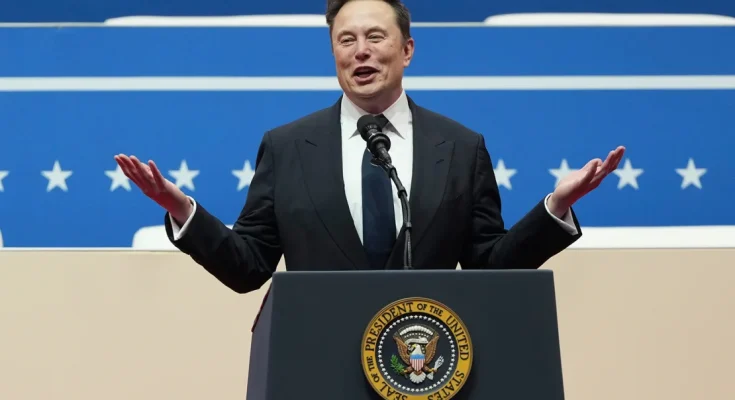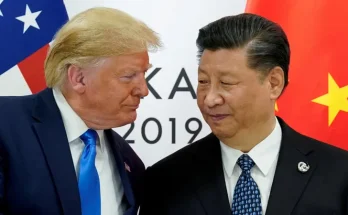Trump and Musk’s Federal Takeover Sparks Chaos, Firings, and Lawsuits
In less than three weeks, former President Donald Trump and tech mogul Elon Musk have launched an unprecedented shake-up of the federal workforce—firing top officials, freezing billion-dollar agencies, and pushing tens of thousands of employees to voluntarily walk away from their jobs.
And this, they insist, is just the beginning.
Musk’s aggressive takeover of the federal bureaucracy, championed by Trump supporters, has ignited a storm of fear, outrage, and legal battles. With the administration’s goal of slashing government agencies and purging officials deemed “hostile” to Trump, federal employees are caught in a whirlwind of uncertainty.
Some of the most drastic measures have hit legal roadblocks—at least for now. A federal judge recently halted a looming deadline for the controversial buyout program, allowing more time for court challenges. This follows earlier rulings that froze a sweeping government spending halt and restricted Musk allies’ access to sensitive financial systems within the Treasury Department.
Yet, Musk’s pace remains relentless. From demanding control over classified payment systems to gutting the U.S. Agency for International Development—where employees are being placed on leave and recalled to the U.S.—his influence is reshaping the government at breakneck speed.
The first 19 days of Trump’s return to power have exposed the sheer force of Musk’s impact. His takeover playbook—eerily reminiscent of his overhaul at Twitter—has bulldozed federal norms, sweeping aside those who challenge his hand-picked operatives at the newly formed Department of Government Efficiency (DOGE).
Among the most consequential moves is the administration’s controversial “buyout” program, offering federal employees a choice: leave now but continue receiving pay through September. The memo sent to two million workers bore a familiar, ominous subject line—“Fork in the Road”—the same phrase Musk used when he gutted Twitter’s workforce in 2022.
The message is clear: this is a hostile restructuring of the federal government. And it’s far from over.
Trump and Musk’s Federal Overhaul: 65,000 Resignations, Forced Layoffs, and Legal Battles
Just hours after a judge temporarily blocked the federal buyout plan, a White House official revealed that at least 65,000 federal employees—about 3% of those offered—had opted in to the deferred resignation program. But the Trump administration has set its sights much higher, aiming to push out 5% to 10% of the federal workforce through voluntary exits and sweeping layoffs.
And for those who refuse to leave? Mass terminations are on the horizon.
A Government Shrinking at Warp Speed
Trump’s aggressive push to downsize the government isn’t just a Washington issue—it’s a national one. The majority of federal workers live outside the capital, including tens of thousands in Republican-led states, meaning the effects of these cuts will ripple far and wide.
But Musk’s influence is only part of the story. Trump’s efforts to purge government employees he views as ideological or personal opponents extend far beyond Musk’s restructuring. Across multiple agencies, acting leaders have swiftly fired top officials—targeting employees in DEI offices, prosecutors involved in Trump-related cases, and career civil servants in key policy roles.
The Great Federal Purge
Nearly 2.4 million federal employees received the deferred resignation offer, with exceptions for military personnel, postal workers, and those in immigration and national security roles. Yet even within those ranks, entire departments are being targeted. In a striking move, CIA Director John Ratcliffe ordered the offer to be sent to every single CIA employee.
A recently uncovered internal email to federal supervisors provides a glimpse into how the layoffs are being structured. The message asks agency leaders to assess workers based on specific criteria—including “unique specialized skills or knowledge”—to determine who stays and who goes. Cybersecurity personnel, disaster coordinators, and emergency management specialists are among the few groups receiving exemptions.
For many federal employees, the decision to leave isn’t just financial—it’s deeply personal. One EPA union official described the mood among workers:
The Next Targets
With tens of thousands already opting in to the buyout, Trump’s next focus is on forced removals. Among the employees in the crosshairs:
- “Probationary” workers—those employed for a year or less, who can be fired without appeal.
- Older federal employees—pushed into early retirement.
- Remote workers—Trump has ordered all federal employees back to the office full time, despite existing union agreements supporting telework.
Trump has also revived and expanded a controversial plan to strip key civil servants of job protections. One of his Inauguration Day executive orders created a new classification—Schedule Policy/Career—which would make it far easier to fire government employees involved in shaping policy. Critics argue this is a way for Trump to replace nonpartisan civil servants with loyalists, much like the Schedule F initiative he attempted in 2020.
Federal employee unions are already fighting back in court, arguing that Trump’s attempt to override 2024 Biden-era job protections is illegal. The American Federation of Government Employees (AFGE), the largest federal union, has slammed the administration’s guidance that agencies should “ignore” collective bargaining agreements.
A Government in Turmoil
With legal challenges mounting and government agencies in upheaval, Trump and Musk’s efforts to reshape the federal workforce are only just beginning. The administration’s strategy is clear: make it as easy as possible to remove career civil servants and replace them with loyalists.
For federal employees, the choices are narrowing: leave on your own terms—or risk being forced out.
Trump’s Federal Overhaul Hits Agencies Hard: USAID, CFPB, and Education in the Crosshairs
The Trump administration’s efforts to dismantle the federal government have hit USAID the hardest, following an executive order freezing most foreign aid.
On Friday, large portions of USAID’s workforce were placed on leave, leaving hundreds of employees overseas scrambling to figure out their next steps and when—or if—they will return to the U.S. Sources say the administration plans to retain fewer than 300 employees at the agency, which currently operates with thousands of staff worldwide.
The shake-up at USAID escalated rapidly. Nearly 60 senior staffers were put on leave within Trump’s first week in office, accused of attempting to “circumvent the President’s Executive Orders.” Two senior security officials were also suspended after allegedly blocking officials from the newly created Department of Government Efficiency (DOGE) from physically accessing USAID headquarters.
Then, in a stunning move on Monday, USAID was effectively absorbed by the State Department. Secretary of State Marco Rubio declared himself the agency’s acting leader, while Musk took to X (formerly Twitter) to gloat that he and his team had spent the weekend “feeding USAID into the wood chipper.”
Trump’s Cabinet Moves to Take Over Key Agencies
Though Trump cannot unilaterally eliminate federal agencies without congressional approval, his administration’s aggressive restructuring has had a suffocating effect on institutions he aims to weaken.
Rubio isn’t the only official overseeing a hostile takeover. Treasury Secretary Scott Bessent was installed as acting head of the Consumer Financial Protection Bureau (CFPB) after Trump fired its director, Rohit Chopra. Bessent has since launched a full review of the agency—established in the wake of the 2008 financial crisis to protect consumers—to ensure its operations align with the new administration’s vision.
And the Education Department could be next. Trump has openly stated his desire to eliminate the federal agency altogether, pushing to shift education policy back to the states.
With each passing day, Trump and Musk’s radical restructuring of the federal government is accelerating, leaving agencies in turmoil and thousands of federal employees uncertain about their futures.

Trump and Musk’s Government Overhaul: Retaliation, Agency Takeovers, and Legal Battles
The Trump administration’s radical shake-up of the federal government is accelerating, with sweeping personnel purges, hostile takeovers of key agencies, and mounting legal challenges.
At USAID, nearly 60 senior staffers were placed on leave just a week into Trump’s presidency, accused of attempting to “circumvent the President’s Executive Orders.” Two senior security officials were also suspended after allegedly blocking Department of Government Efficiency (DOGE) officials from entering USAID headquarters.
Then, in a stunning move on Monday, Secretary of State Marco Rubio declared himself acting head of USAID, effectively absorbing the agency into the State Department. Musk, meanwhile, boasted on X that he and his team had “spent the weekend feeding USAID into the wood chipper.”
While Trump cannot unilaterally dissolve federal agencies—an act requiring congressional approval—his administration’s aggressive tactics are effectively strangling those he deems unnecessary.
A Government Reshaped
Rubio isn’t the only Trump ally seizing control of a key agency. Treasury Secretary Scott Bessent has taken over as acting head of the Consumer Financial Protection Bureau (CFPB) after Trump fired its director, Rohit Chopra. Bessent immediately launched a review to align the agency—created to protect consumers after the 2008 financial crisis—with Trump’s new agenda.
The Education Department could be next. Trump has made clear he wants to eliminate it entirely, shifting responsibility for education to the states. “I told Linda, ‘Linda, I hope you do a great job in putting yourself out of a job,’” Trump said Tuesday, referring to Education Secretary Linda McMahon.
Meanwhile, the administration’s restructuring efforts are causing ripples across other agencies. More than 160 Environmental Protection Agency employees working in the Office of Environmental Justice and External Civil Rights were placed on paid administrative leave this week, according to Family Us.
Punishing Trump’s Enemies
At the Justice Department, the focus has been as much on political retribution as it has been on workforce reductions.
Before Attorney General Pam Bondi was sworn in on Wednesday, Trump appointees had already ousted officials involved in investigations against Trump, forced senior FBI leaders to retire or resign, and compiled a list of more than 5,000 FBI employees involved in January 6-related cases, sources said.
Beyond targeting perceived enemies, the Justice Department is also pushing broader workforce reductions. An internal memo revealed plans to encourage older federal workers to resign early through the Voluntary Early Retirement Authority (VERA) program—part of Trump’s goal to shrink the federal workforce by up to 10%.
Yet, the buyout offers have had limited success, mostly appealing to employees already near retirement. Some Justice Department employees have even chosen to stay as an act of defiance.
“The emails from the beginning have been insulting and demeaning,” one official told Family Us. “It’s stupid to think that people who aren’t in it for the money could be bought out with money.”
Roadblocks and Legal Challenges
Despite the administration’s aggressive moves, the courts are beginning to push back.
A judge temporarily halted Musk’s deferred resignation program, marking another legal setback for Trump’s early executive actions. Last week, two judges blocked an attempt to freeze federal grants and loans, forcing the Office of Management and Budget to withdraw its sweeping spending pause.
The administration’s efforts to bypass the Impoundment Control Act—a law preventing the Executive Branch from withholding congressionally approved funds—are now under scrutiny.
Meanwhile, a federal judge has limited DOGE officials’ access to a sensitive Treasury Department payment system after Musk’s team attempted to cut off USAID funding overnight.
With legal battles mounting, many of these cases may ultimately reach the Supreme Court, which could decide just how much power Trump and Musk have to reshape the federal government.

Legal experts suggest that Trump’s most aggressive attempts to reshape the federal government may face significant hurdles in the courts—even from a Supreme Court that has previously ruled in his favor.
Stephen Vladeck, a Family Us legal analyst and professor at Georgetown Law School, warned that while the Supreme Court sided with Trump in last year’s immunity case, it may not be as receptive to his administration’s most extreme overhauls.
“I think Trump is going to lose more of these cases than he’s going to win,” Vladeck said. “Even this Supreme Court is going to take serious issue with just how radically and how quickly the administration is trying to rewrite decades, if not centuries, of settled law.”
Lower courts, he added, are likely to be even more skeptical, especially given the widespread disruption these policies are already causing. “The more harm these actions inflict on the ground, the more inclined judges will be to block them while the litigation unfolds.”



